Rani Padmani has been accorded the stature of deity not only in many homes across Rajasthan, irrespective of caste, but throughout India. In the ‘Doll House’, Padmavati represents a queen who chose to immolate herself along with other womenfolk wearing saffron instead of falling into the hands of an invader, Alauddin Khilji. Padmini (author’s mother’s namesake ‘Padmani Rani’); symbolizes many women considered brave and pious.
Goddess Padmavati is revered, just as Meera Bai – another Rajput princess who too married into the royal house of Chittorgarh more than 300 years later. Padmini as an ideal of Indian womanhood that chooses death over dishonor.
‘With blessings of the god Shiva, Padmini appears before Lakshmansinha (rular of Chittor as per one narration) and his ministers as a goddess, and demands a blood sacrifice from them. The women of Chittor die in mass self-immolation, while the men fight to death. The victorious Alauddin razes all the buildings in Chittor, except Padmini’s palace and then returns to Delhi.’ – Epigraphic evidence contradicts James Tod’s claim that the contemporary ruler of Mewar was Lakshmanasimha (Lachhman Singh), not Ratnasimha (Ratan Singh or Ratan Sen).
Maruti Suzuki gave us good rides, more to and fro & in Rajasthan; I did two sojourns with my wife, Dr. Vishav Kirti; & my two school going boys who, I am sure, enjoyed, asking for more; & we did Chittor.
Chittorgarh Fort (UNESCO World Heritage Site) is one of the largest forts of India spread over 700 acres and situated on a high hill near the Gambheri River. The biggest Rajput festival –Jauhar Mela takes place every year on the anniversary of one of the Rani Padmini’s jauhar in the month of February – March. This act, also described as “johar”, has a socio-religious significance.
“It is said that here Rana Ratan Singh showed a glimpse of legendary beauty of his wife Padmini to Aloudin Khilji through a mirror. After which Aloudin Khilji went to the extent ravaging Chittor in order to possess her,” … reads a board by the Archeological Survey of India (ASI) at the entrance of Padmini Palace in Chittorgarh.
Both my sons, Aseem & Manu, liked knowing history of Rajputana. Moral stories are those that are learnt at childhood, when the soul is pure and clear, and remembered for the rest of our lives. They are also passed on to generations. Alauddin Khalji’s siege of Chittor in 1303 CE is a historical event. Although the legend of Padmini is the best known story about the siege.
Through the stories one can learn the various aspects of our lives and apply the Moral learnt through the stories in our everyday lives. The underlining principles would be truth, love, mutual respect, righteousness, rectitude, divinity, priority to societal unity, etc… People have tales to tell:- “Historical Saga of Johar is a rarest of rare incidents of history” “Look at the Jal Mehal, believed to be the summer palace of Rani Padmini, the 12th century queen of the kingdom of Chittor in Rajasthan’s Mewar region..”. “.. A queen so beautiful that the Sultan of Delhi, Alaudin Khilji, driven by lust attacked the kingdom of Chittorh in 1303….”
“As the queen set on the steps of Jal Mahal, her reflection in the waters of the Padmini Lake fell on a mirror in Padmini palace, where Khilji stood…” “The sixteen thousand women didn’t die without reason”
“Rani Padmini is our Devi. The Mughals were obsequious to the English enhance their versions who gained prominence… (Alaudin) Khilji and no foreign man ever saw her”. “Nobody has seen even her finger nail”
“The first major English version by Col. James Tod is set to have lent credibility to the mirror version fighting for the honor of a women. With every such re-telling, the legend of Padmini gets fortified and is now almost unimpeachable, much like the fort built on the table top plateau of the Vindyachal range of mountains; any deviation from this script can be risky.”
I was deeply taken up with the prowess of story telling of the people, moved by the theme and moral, my imagination woke up.
Back home, accompanied by my friend Er. Vinod Sagar of Titla Hotel, I shared my imaginative sketch with an artist in Jhakoo, Shimla; who took quite some time to paint the theme, as it props up in the Doll House. Manu presented a doll to his mom, year after year, wishing to have a biological sister(a daughter in our family). We still have a good collection of dolls at our home ‘kirti Cottage’ making it a ‘Doll House’
From a distance, being in Dalhousie, on telephone, I would share my thoughts and even suggest the brush strokes. At times the iconic figure of Maa Padmani & sometimes the facial expressions of Allauddin and his accomplice; as also the attire and turbans of the lustful invaders. Made to represent the true spirit of our culture, the idea is to illustrate the greatness of our human culture real-life stories with valuable lessons. “She is like a mother. It’s important to be cautious about how we portray her for the next generation.” Grandeur of this masterpiece spread far and wide. Curiosity aroused among our Family friends and many more to have a look at this splendid painting; & to get portrayed against the backdrop of this work of outstanding artistry.
Isabelle, a French, was fantasized, glaring at the painting; besides her husband Lord Vijay a British Indian.
Dr. Avinash Chander an Indo-American, by the side of his sister Dr. Vishav Kirti, is highly appreciative of this object of art, depicting high values of our rich Indian culture and the heritage.
According to Dr. Natwar Singh Principal, Chittorgarh Ayurveda College from “a girl as young as three to an 80 year over jumped in to a Juhar. Not one women remained that’s how our great women were”.
Padmini, also known as Padmavati, was a legendary 13th-14th century Indian queen (Rani). The earliest source to mention her is Padmavat, an epic fictionalized poem written by Sufi Malik Muhammad Jayasi in 1540 CE. The text, which features elements of fantasy, describes her story as follows: Padmavati was an exceptionally beautiful princess of the Sinhala Kingdom (Sri Lanka). Ratnasimha (Ratan Singh or Ratan Sen), the Rajput ruler of Chittor, heard about her beauty from a talking parrot named Hiraman. After an adventurous quest, he won her hand in marriage and brought her to Chittor.
Alauddin Khalji, the Sultan of Delhi also heard about her beauty, and laid siege to Chittor to obtain her. Many events occurred during the period of the Siege, till the Fort was finally taken. Meanwhile, Ratan Sen was killed in a duel with Devpal, the king of Kumbhalner who was also enamored with Padmavati’s beauty. Before Alauddin Khalji could capture Chittor, Padmavati and her companions committed Jauhar (self-immolation) to protect their honour. After her sacrifice, the Rajput men died fighting on the battlefield.
Author of about 25 works including Padmavat, Jayasi who wrote in Awadhi, is counted among the prominent writers of Medieval classics. “Jayasis Padmavat is a canonical text. Common to Hindi & Urdu classical texts, it is equally revered by both and often cited as a bridge between the two often warring languages which share a common literary tradition.” Says Delhi based writer Rakshanda Jalil like Kabir, “he got Hindus & Muslims together”.
The narrative of Jaysi Ballads is rich with emotion and pathos; weather it relates to any contentious historical or mythological incidents or events, weather it is a traditional rendition, a mythic retelling; or a historical recreation. Even if it were a Portrayal of Mythical Characters from history, Yet these are larger than life which makes them attractive. Biographic details of Jayasi are sketchy. In the year since he wrote it, Padmavat has been re-told and re-shaped a number of times by Sufi Saints, Rajputs Storytellers, Jain Monks, Hindu Nationalists, and British Imperials.
In his later years, Jaysi is set to have shifted to Ramnagar, where he got a patronage of his kings. Saiyyed Muhammad Moin Shah, who administers dargah of Jayasi in Ramnagar says, “It talks of a mystical love, it’s characters personify things. In essence, it is about Atma & Parmatma. The romance, the story are just a frame”. More than a century after his death, his name started appearing in hagiographies that portrayed him as a Sufi Peer. Many in the region surrounding Amethi rever Jayasi more as Peer than Poet.
“See what he means to people here,” says Moin Shah. But still, he says, “Jaysi’s work will survive him & the cast of his epic.” He quotes from Padmavat to make his point “Kahan so Ratansain ab Raja?…/Kahan Alaudin Sultanu?/ Kahan Saroop Padmavati Rani/Koi na raha, Jug rahi Kahani (where israja Ratansain now? Where is Sultan Alaudin? Where is the beautiful Padmavati?. They are not here, there story is)”.
The earliest source to mention the Chittor siege of 1303 CE is Khaza’in ul-Futuh by Amir Khusrau, who accompanied Alauddin during the campaign. Some scholars, such as Ashirbadi Lal Srivastava, Dasharatha Sharma, and Mohammad Habib, have suggested that Amir Khusrau makes a veiled reference to Padmini in Khaza’in ul-Futuh.
Excerpts from subsequent narratives and a few related anecdotes and episodes, are, however ,placed below:-
- ‘Rajput ruler of Chittor, hearing about her beauty from a talking parrot named Hiraman’
- ‘Alauddin learns about Padmini’s beauty from a singing girl, and invades Chittor to obtain her’.-
- ‘While Ratan Sen and Padmini were making love, a Brahmin named Raghav Vyas accidentally interrupted them. Fearing Ratan Sen’s anger, he escaped to Delhi, where he was received honourably at the court of Alauddin Khalji.’
- ‘A brave and noble warrior-king , apart, from being a loving husband and a just ruler, Ratansen was also a patron of the arts. In his court were many talented People one of whom was a musician named Raghav Chetan. But unknown to anybody, Raghav Chetan was also a sorcerer. He used his evil talents to run down his rivals and unfortunately for him, was caught red-handed in his dirty act of arousing evil spirits. On hearing this, King Ratansen was furious and he banished Raghav Chetan from his kingdom after blackening his face and making him ride a donkey. This harsh Punishment earned king Ratansen an uncompromising enemy. Sulking after his humiliation, Raghav Chetan made his way towards Delhi with the aim of trying to incite the Sultan of Delhi Ala-ud-din Khilji to attack Chittor.’
- ‘But to his dismay, on reaching Chittor, Allah-ud-din found the fort to be heavily defended. Desperate to have a look at the legendary beauty of Padmini, he sent word to King Ratansen that he looked upon Padmini as his sister and wanted to meet her. On hearing this, the unsuspecting Ratansen asked Padmini to see the ‘brother’. However, Padmini was more wordly-wise and she refused to meet the lustful Sultan personally. On being persuaded by her husband Rana Ratansen, Rani Padmini consented to allow Ala-ud-din to see her, only in a mirror. On the word being sent to Ala-ud-din that Padmini would see him he came to the fort with his selected best warriors who secretly made a careful examination of the fort’s defenses on their way to the Palace. On seeing Padmini, in the mirror, the lustful ‘brother’, Allah-ud-din Khilji decided that he should secure Padmini for himself. That was when two loyal generals of the king Gora and Badal decided to beat the Sultan at his own game, devised a plan and sent a message to the Sultan that the queen had agreed to go with him. The next day, over one hundred palanquins made their way to the Sultan’s camp and he was told that the queen was coming with her maids. Only she wasn’t.
- But to his surprise from the palanquins came out, not his queen and her women servants but fully armed soldiers, who quickly freed Ratansen and galloped away towards Chittor on horses grabbed from Ala-ud-din’s stables.
- On hearing that his designs had been frustrated, the lustful Sultan was furious and ordered his army to storm Chittor.
Several subsequent adaptions of the legend characterised her as a Hindu Rajput queen, who defended her honor against a Muslim invader. Over years, she came to be seen as a historical figure, and appeared in several novels, plays, television serials and movies. But Padmini as an ideal of Indian womanhood who chooses death over dishonor is perhaps what unites Jayas with far away Chittor.
Between 16th and 19th centuries, at least 12 Persian and Urdu translations or adaptations of Malik Muhammad Jayasi’s Padmavat were produced. More Urdu versions appeared in the 20th century, all adhering to Jayasi’s love poetry tradition.
In 1589 CE, Hemratan composed Gora Badal Padmini Chaupai, the first Rajput adaption of the legend, presenting it as a “true tale”. Between 16th and 18th centuries, more Rajput versions of the Padmavati legend were compiled in present-day Rajasthan, under the patronage of the Rajput chiefs. Unlike Jayasi’s theme of courting and marriage, the Rajput adaptions emphasized their honour in defending their kingdom against Alauddin Khalji. No lust theory: A large section of Rajputs has always questioned the story in Jayasi’s poem Padmavat – that Khilji attacked Chittorgarh because of his lust for Rani Padmini. Rajputs strongly refute any likelihood of Padmini’s husband, Rana Ratan Singh agreeing to show Khilji his wife’s reflection given the kind of purdah that was maintained for women and guarded zealously by men.
During 1829-32, James Tod included a colonial re-telling of the legend in his Annals and Antiquities of Rajasthan. His version was based on the information compiled from the oral and textual traditions of writers employed by the Rajput chiefs. She was famous for her beauty, and Alauaddin (alias Ala) bisieged Chittor to obtain her. After negotiations, Ala restricted his demand to merely seeing Padmini’s beauty through a mirror. However, subsequently, he treacherously captured King and demanded Padmini in return for his release.
As a result, Padmini and other women committed self-immolation (jauhar). King and other men then fought to death, and Alauddin captured the fort. Ireland-born Sister Nivedita (1866–1971) also visited Chittor and historicized Padmini.
Then there were the Bangali Narrative of the 19th century, which says Sree Nivasan “Re-interpreted the legend yet again to celebrate a Hindu Queen who had emulated herself to defend her chastity against a lustful, treacherous Muslim Invader”.
Yagneshwar Bandyopadhyay’s Mewar (1884) vividly describes the jauhar (mass self-immolation) of Padmini and other women, who want to protect their chastity against the “wicked Musalmans”.
Kshirode Prasad Vidyavinode’s play Padmini (1905) is based on James Tod’s account: Nevertheless, his account of Alauddin and Padmini follows Tod’s version with some variations.
When the British writer James Tod, who is now considered to be unreliable, compiled the legends of Rajasthan in the 1820s, he presented Padmini as a historical figure, and Padmini came to be associated with the historical siege of Chittor.
In the 19th century, during the Swadeshi movement, Padmini became a symbol of Indian patriotism. Indian nationalist writers portrayed her story as an example of a heroic sacrifice, and a number of plays featuring her were staged after 1905.
Abanindranath Tagore’s Rajkahini (1909) is also based on Tod’s narrative. Alauddin learns about Padmini’s beauty from a singing girl, and invades Chittor to obtain her. It popularized her as a historical figure among schoolchildren. Later, some history textbooks began to refer to Khilji invading Chittor to obtain Padmini. Jawaharlal Nehru’s The Discovery of India (1946) also narrates Khilji seeing Padmini in a mirror; Nehru’s narrative is believed to be based on recent local poets.
By the 20th century, some elite Rajput women of Rajasthan characterized Padmini as a historical figure who exemplifies Rajput womanhood. She has become a symbol of valour and sacrifice in Rajput history. Hindu activists have characterised her as a chaste Hindu woman, and her suicide as a heroic act of resistance against the invader Khilji. A brave and pious heroine Padmavati captures Rajput Valor, dignity and tradition in all its glory.
Juhar Samriti Sansthan, an organization that seeks to equate Juhar with the idea of sacrifice and compassion. ‘Her act of Johar gave the world a new direction. Now we all share the same ideology’.
Any assertion that Rani Padmini – was a mere figment of imagination is an affront to those who rever her. Even Rao Shivraj Pal, a royal history enthusiast, rubbishes the idea. Jaipur Maharani Padmini Devi and her daughter, BJP MLA Diya Kumari are also opposed to any distortion.
“The focus in Rajasthan was not only courting and marrying the queen-and emphasis that had been central to Jayasis Sufi ethic. Instead, these somewhat later narratives of Padmini focused on the exemplary honor of the Rajputs in defending their queen and kingdom against Sultan Alaudin Khilji,” writes Ramaya Sree Nivasan in her insightful book on the subject, The Many Lives of a Rajput Queen.
The room, where Singh is said to have showed Padmini’s glimpse to Khilji, on which overlooks the ‘Jal Mahal’ where Padmini was claimed to stay, now stands sealed. The truth is Padmini did Jauhar and now represents the pride of all women of India.
Courtesy Kirti Cottage, Dalhousie
Prof. (Er.) Chander P Mahajan is an art critic & a free lance journalist. The Environmentalist stays in Shimla and Dalhousie, Himachal Pradesh, India.


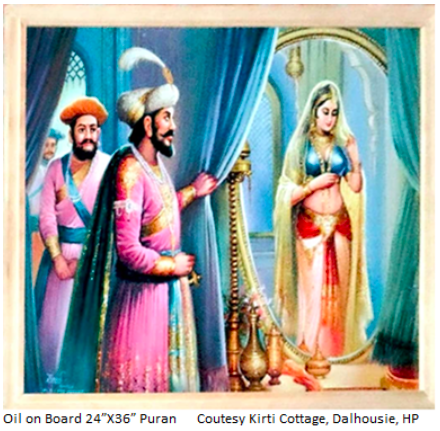
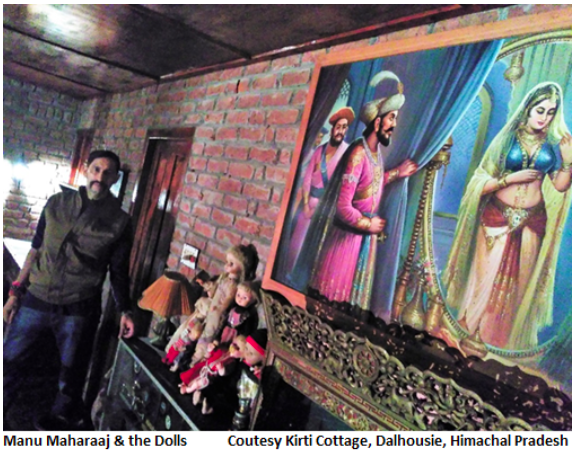
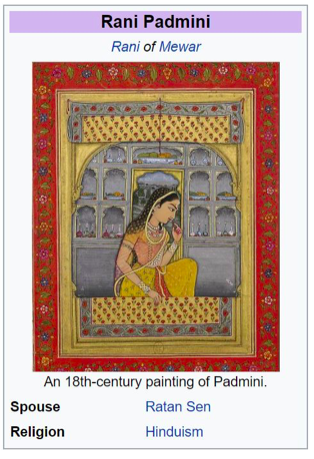
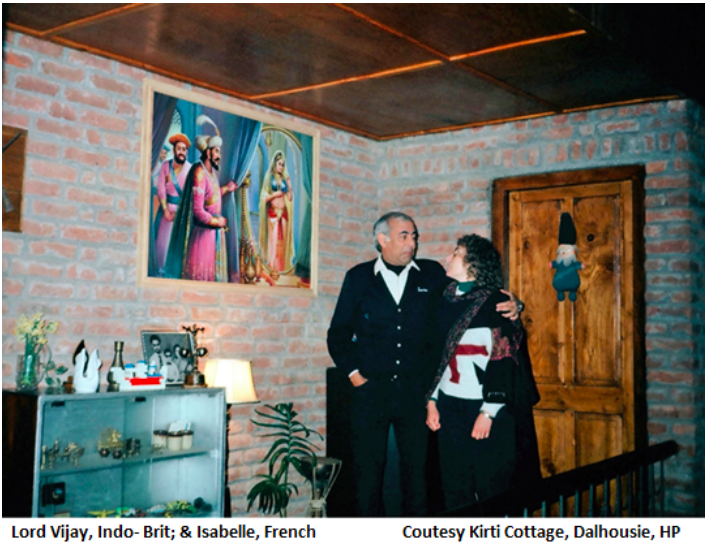
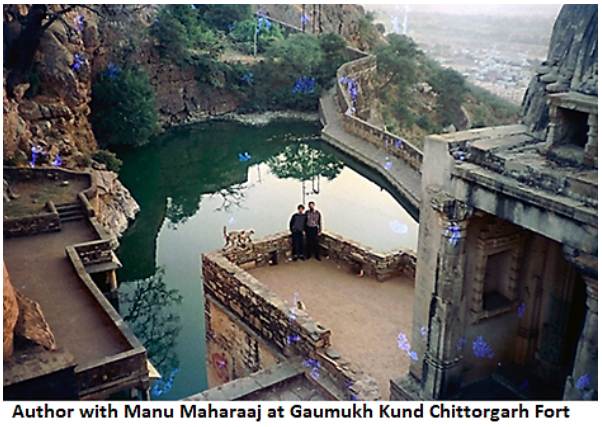
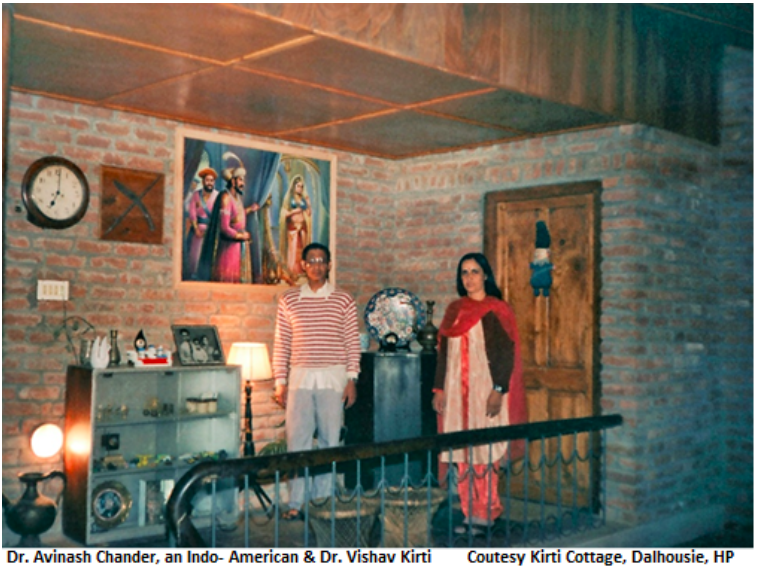
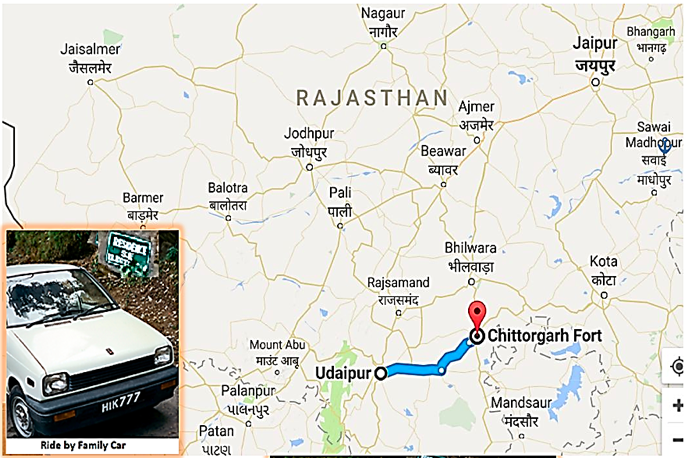
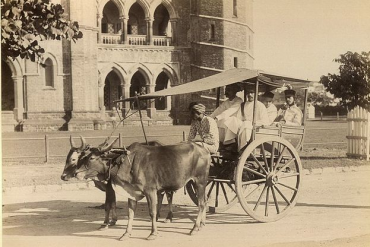
Fascinating and extremely informative. Just shows that ancient history cannot be reduced to simple binaries, and all versions should be freely available to the public. Thanks, Mr. Mahajan.